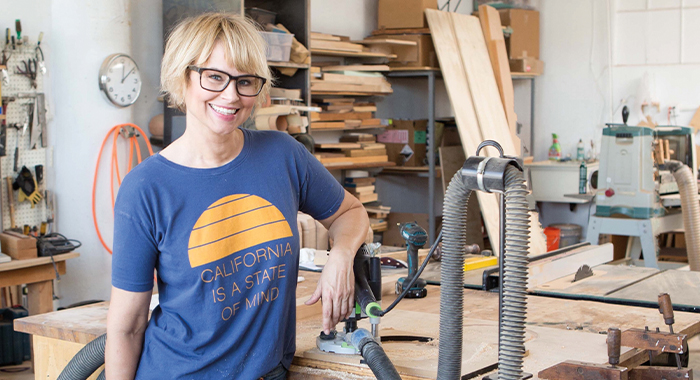Alumni Profile/Life From Death: Planturns Help Heal
Of her career-defining move into cremains preservation C.C. Boyce ’95 says, “I had to take a deep dive into death.”
Boyce makes planturns – likely the only maker – which place the dead beneath the living. Ashes are kept in the hollow base of a hardwood planter, while the top section houses a plant. “You can keep your loved one close, but you don’t have to feel sad every time you look at the planter.”
Boyce grew up near the Wisconsin/ Illinois border, exploring her engineer father’s woodwork shop in the basement, and arrived at St. Norbert to major in communications, media and theatre with a full toolbox. “It was natural to me to go and make things,” she says.
A first career as an actor took her to Hollywood in the late 1990s. “I did well in commercials and voiceover, but after the commercial actors’ strike of 2000 a lot of work went non-union.” She became a DIY blogger, went back to school to study woodwork and cabinet-making and sold restaurant tables, window seats and fitted cupboards. Then her traditional hardwood planters were featured in top interiors magazines and her workshop appeared in Apartment Therapy. She now has a new workshop in the Fashion District of downtown LA.
The first planturn was created in 2018, in response to a customer’s request. “They wanted to disperse a family member’s ashes, so I designed something for them.” When she put the result on Instagram, she had a huge response from pet morticians – and from a death doula (someone who prepares individuals and families for the end of life) who became an important resource.
“I spent a year on research, visiting crematoria, talking to everyone in the death-care industry, developing prototypes.” After raising Kickstarter funds, she was in full production in time for the pandemic-led boom. “I lost my second job in a restaurant when COVID hit, but I had some savings, so I thought, ‘it’s all or nothing.’
“It takes 2 to 3 hours for a small piece and 4 to 5 hours for medium or large. I do milling and assembly one day, finishing and sanding the next. The small pieces take less time because both pieces are solid. The bottoms of the larger pieces are hollow. I mill the wood, split it down the middle and mill it again so the grain matches, and when I curve the edges it looks solid. The magnets are invisible. It takes longer but that’s the difference between something looking OK and looking great.
Boyce's reach is now global. “Australia is particularly interested at the moment, but they are selling everywhere.”
She doesn’t envisage her business becoming an empire, though. “I would never hand this over to anyone else. I don’t want to be a mogul.
“You have to talk [clients] through it. I realised I am well-equipped for this; I’ve been around death a lot from a young age. Both my parents died of COVID, and I also lost my two senior cats recently. I can somehow empathise with grief without taking it on. And I live and work alone, so it’s great to be able to connect with people quite deeply in this way.”
Boyce is not making a planturn for herself, she’s got something else in mind: “I want my remains to go to a body farm to contribute to studies on the effects of decomposition. You are helping solve crimes, and I’m a true crime nut.”
You can view her planturns and other work at boycestudio.com.
Nov. 5, 2021












